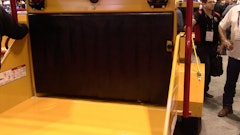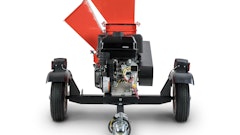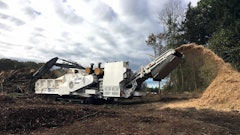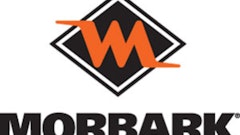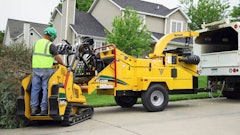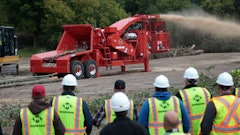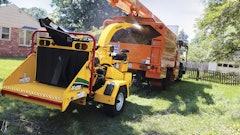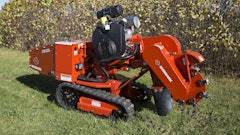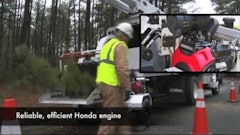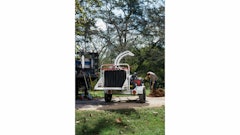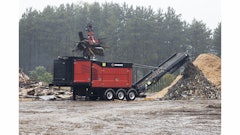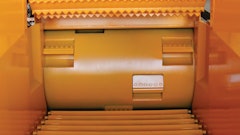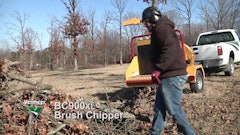
While horizontal grinders have become the latest fad for recycling green waste on jobsites, chippers still provide an attractive alternative for some site clearing operations. Though they can't handle root balls and are sensitive to dirt and debris, chippers are very efficient with clean wood.
"We are seeing an increase in contractors purchasing wood chipping equipment to reduce costs and minimize time spent on the job," says Jason Showers, regional sales manager, Morbark.
"A chipper is much more efficient at getting rid of your above-ground material," says Jerry Morey, president, Bandit Industries. "The feed rate of most of the whole-tree chippers are in the area of 120 fpm. A grinder is generally getting rid of it at the rate of 25 to 30 fpm."
In addition, the operational costs are lower. According to Morey, it takes more horsepower and quite a bit more fuel to grind wood vs. chipping it.
Bob Campbell, sales manager, Woodsman Chippers, adds, "The grinder produces a shredded material created through hammering or busting the material apart vs. cutting it. When you are cutting the material, it is a lot easier to process with less horsepower and less fuel consumption."
The initial purchase price for a chipper is also generally a lot less than a grinder. "Grinders are a lot more money because they have to be built much heavier," says Campbell.
Chipper choices
Not all chippers are created equal. Some contractors prefer disc-style chippers, while others prefer drum-style models. "The disc chippers chip easier with less fuel and require less horsepower," says Morey. But drum-style chippers tend to have larger infeed openings. "The advantage is when you get to the crotches in the tree. They go through the drum a little easier than they do the disc."
Drum-style chippers can also be more compact. "With the drum-style chippers, you have the ability to process larger diameter trees without the whole machine increasing in size," says Campbell. "Every time you increase the disc size, the whole machine all the way around has to get much larger. The drum-type chipper is more of a versatile machine because of its compactness."
In-feed size is also an important issue when choosing a chipper. "Chippers in the 19- to 21-in.-diameter range are popular," says Mark Rieckoff, environmental segment manager, Vermeer Mfg. Co. "Contractors can tow them down the street and work on tree takedowns, then go out on a 5-acre site development project and process trees and brush."
Showers indicates, "The majority of contractors in the Northeast are purchasing 18- to 20-in. machines. Generally, these machines are built heavier and can handle being fed with auxiliary equipment such as an excavator, reducing the contractor's need for additional equipment and manpower."
To make sure you're purchasing the correct machine, Showers advises consulting with your sales professional and reviewing your options to determine the size and type of equipment that best suits your individual needs and budget.
The end results
The end products from a grinder and a chipper are different. "A grinder offers endless options to change the size of the end products by simply changing screens. Grinders can also be equipped with coloring systems that further enhance the value of the resulting end product."
These differences can make ground products more profitable. "If possible, the end product should also create a revenue stream for the contractor," says Rieckoff.
Consequently, chipped product has traditionally been viewed as less valuable, often being spread back on the site. "A chipper is for product reduction," says Rieckoff. "The ROI comes from the job, such as a tree takedown or site clearing."
However, this is starting to change in certain areas. "Because of the high energy prices, they are putting in a lot of wood-fired power plants," says Morey. "Those guys are competing mainly for the same type of material. The chip is actually a better fuel wood product than ground material in most cases, although we have customers selling fuel wood out of both the chippers and the grinders."
"We are seeing a lot of biomass facilities, cogeneration plants, opening up," Campbell agrees. "It is going to expand just due to the cost of fossil fuels increasing and the fluctuation in the cost. People are looking at renewable resources. Wood is one of the greatest renewable resources that we have."
The market really depends on the region of the country. "In the Northeast and some places in the Midwest, fuel wood prices went up to where contractors are changing their land clearing schemes to allow them to reclaim that material," says Morey.
Campbell has also observed this trend. "Ever since biomass has opened up, instead of discharging product to the ground like they had in the past, a lot of contractors are trying to find a market in which to sell the end product," he states.
Some larger contractors have actually invested in both chippers and grinders. "The bigger ones - if there is a fuel market in the area - are into both mulch and fuel," says Morey.
A clean approach
Chippers do dictate that material be handled differently from a grinder. You have to take more precautions to prevent excess wear on the knives, which means the material must be kept a lot cleaner.
"Let's say you push the material in a pile with bulldozers. That creates two problems," says Morey. "It is difficult to get out of the pile, and more than likely you are going to roll some dirt and rock in there, which is hard on the knives. The guys who are doing land clearing using a chipper are also using a feller buncher. They are using a mechanized machine to cut and pile the material."
To operate a chipper efficiently, material flow and placement on the site are crucial. "It is better to stage or stockpile the material to maximize production," says Rieckoff. "The contractor should also consider placement of the chipper on a jobsite. Position the machine for optimal production by placing it as close to the project as possible, thereby reducing the time it takes to move materials to the chipper."
An inefficient setup - where material must be hauled to the chipper and it is not being constantly fed - will drive up costs. "I have been on jobsites where the chipper is running at full throttle, but materials are not being fed into the unit," says Rieckoff. "This puts more hours on the machine and costs money in terms of fuel and operating costs."
Keeping blades sharp and periodically replacing them is also key to efficient chipper operation. "Chippers are fairly straightforward to be honest with you," says Campbell. However, he cautions that you need to take a close look at how replacement blades are manufactured. "Some knives are stamped vs. those that are actually cut. There is a difference between the durability and the wear."
CHIPPER SAVES DISPOSAL COSTS The company started using roll-offs to get rid of debris from its site clearing operations. "We were paying around $500 for a roll-off," recalls Demarr. But then the cost began to rise. "They got up to $700. So then we decided to buy a demolition trailer and tractor and haul the material ourselves." The cost for dumping a demo trailer of material was around $775. To minimize the amount of material being hauled away, Demarr decided to investigate the purchase of a chipper. The company starting out looking at bigger chippers. But its jobsites are fairly confined, plus Demarr couldn't justify the purchase price. "I thought about one of those self-propelled chippers that has tracks on it, but they are around $200,000," he says. Even a used tub grinder proved to be more expensive. A step above that is a horizontal grinder priced at around $650,000. Ultimately, the local Morbark dealer suggested an 18-in. chipper model. Demarr was sceptical due to its small size. However, it was capable of chipping up to 15-in. material, which was the largest diameter the company required. "Anything over 15 in., we sell the lumber," says Demarr. Once it was delivered, Demarr fed the chipper with a Hitachi 350 excavator with a hydraulic thumb attachment. The trees and brush had to be prepared before being fed into the chipper - the limbs were cut off and the brush was fed in separately. Even so, the productivity of the chipper surprised Demarr. "It is perfect for us," he states. "We will set it up and bring the material to it. It will eat that stuff up." Demarr may take down 20 trees on a jobsite. Most of the wood is chipped on site and blown back onto the ground, where the chips are mixed with the soil. For the stumps, he has relationships with other contractors in the area who own grinders, allowing for economical disposal. These contractors will grind the stumps and sell the end product. Operating costs have proven to be minimal. "The only thing you have to be careful with is you have to change the blades," says Demarr. "If the blades are sharp, that stuff will go right through there. If the blades are dull, then you might have problems. You can burn up a clutch." Demarr has found it more cost effective to just replace the blades rather than re-sharpen them. "We go online and buy the blades," he explains. "You can buy the blades for $160, so it's not worth it for us to sharpen them." The blades are double sided, so if you get 20 hours before the cutting edge is changed, it means they will cost you $80 every 40 hours, Demarr points out. This really depends on how you handle the materials. "If you run a lot of dirt in there, you are only going to get about 10 hours on your knives. We try to keep our stuff pretty clean when we send it through there," he says. In addition, by simply replacing the blades, the anvil on the chipper doesn't need to be readjusted, so there is less chance of error. Demarr has seen immediate returns on his roughly $50,000 chipper investment. He estimates it has the potential to save two demo trailer loads on each job, or about $1,600 in dumping fees. This equates to $17,000 to $18,000 per year. "We figure in about three years we will probably get it back," says Demarr. "It depends how much you are chipping. It could be less." However, Demarr cautions that the decision about which machine makes the most sense really depends on your business model and job size. "Everybody has a different way of doing business," he comments. |
Chipper or Grinder? "The decision should be based on their business model and the size of the product to be processed," he states. "Do they plan to focus on tree takedowns or large site clearing projects? Another area to consider - is there an outlet for the resulting end products? There are more outlets for a ground product that is produced by a tub or horizontal grinder." Other considerations include:
|






